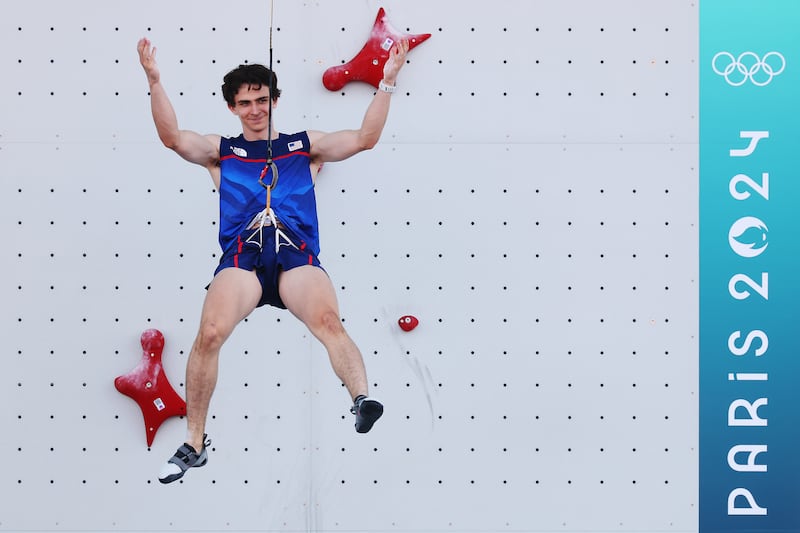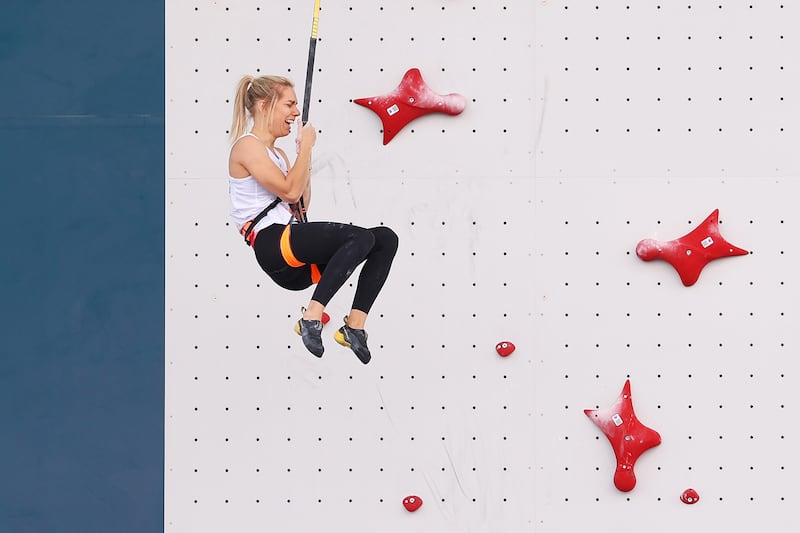At the start, they put two hands over a handhold and one foot on the wall. The buzzer sounded and the two women, side by side, took off, catapulting themselves to the next layer of grips gaining speed as they rose. Speed Climbing is a vertical race to the top of a 15-metre wall.
That’s a five-story building height of 49 feet and the men cover it in less than five seconds, the women six seconds. Defying gravity and moving quicker than you imagine they could, the first to touch a buzzer at the top wins.
It arrived in Tokyo 2020 but its Olympic birth was a difficult one and this year in Paris it is a stand-alone medal sport. Initially it was controversially combined with two other disciplines, Boulder Climbing and Lead Climbing, until climbers pointed out Speed Climbing had little in common with the other two, as it is an entirely different skill.
Poland’s Aleksandra Miroslaw ran up the wall two days ago in 6.06 seconds, a world and Olympic record time. In the men’s event, Texas teenager Sam Watson set a new world record of 4.75 seconds, which puts him at a vertical speed of around three metres per second.
READ MORE

The goal for most elite male Speed Climbers is sub-five seconds. Watson is a phenom in the sport. In 2022, he became the youngest man in history to win a medal at a World Cup event, aged 16, and then set the American speed record the year after.
At the Le Bourget Climbing Venue in north Paris, Miroslaw was the climber everyone had to watch as the women’s finals took off in the morning, the towering wall set up on a stage in an outdoor amphitheatre setting.
When they began, it appeared like an optical illusion as the detail of their hands and feet pushing off the holds was blurred due to the speed they scrambled up. At times it was bewitching as they moved almost as four-legged creatures, not two. Elite climbers don’t touch every hold and appear to skate over the surface, ignoring some grips and favouring others.
Climbing may stretch the definition of the word as the two finalists Miroslaw and Lijuan Deng have trained over and over on the route so that each individual move is memorised and executed as a reflex instead of a conscious action.
American Emma Hunt, the 21-year-old from Georgia, crashed out in the quarter-finals, missing a foot grip. It was a costly stumble and a medal chance vanished. There is no way back from a missed grip or a foot misplacement. And no, she didn’t crash to the ground. Each climber is harnessed for the run with no fear of a bad fall.

The times don’t matter except for record purposes and whoever touched the buzzer first progressed to the next round. The sport is a combination of power in light, agile bodies with high twitch fibres and no small degree of precision.
The wall must be overhanging at exactly five degrees, while the surface is required to have a specific texture. The climbing route itself is always the same – two three-metre lanes – with the same holds made by a certified manufacturer. Everything is standardised so records and times can be held across different countries.
It was to be Miroslaw’s day again but no beating of her newly minted world time. With the win, she became the first Speed Climbing Olympic champion. She crawled speedily up the wall in 6.10 seconds, 0.04 off her own world record and 0.08 seconds faster than her Chinese opponent Deng, who touched the top in 6.18 seconds, a personal best.
“I didn’t think about [my opponent], to be honest. I just heard that it was a close final,” said the Polish champion afterwards. “Before every round I was just focused on this round, whatever happens, this round. I didn’t look on the right side, and the times.”
There were no Irish athletes competing in the draw this time around and none at Tokyo 2020. But who knows in Los Angeles in four years given Ireland’s new Olympic successes and healthy obsession of all things five rings.




















